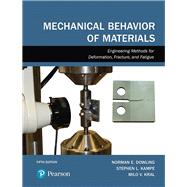For upper-level undergraduate and graduate level engineering courses in Mechanical Behavior of Materials.
Predicting the mechanical behavior of materials
Mechanical Behavior of Materials,5th Edition introduces the spectrum of mechanical behavior of materials and covers the topics of deformation, fracture, and fatigue. The text emphasizes practical engineering methods for testing structural materials to obtain their properties, predicting their strength and life, and avoiding structural failure when used for machines, vehicles, and structures. With its logical treatment and ready-to-use format, the text is ideal for upper-level undergraduate students who have completed an elementary mechanics of materials course. The 5th Edition features many improvements and updates throughout including new or revised problems and questions, and a new chapter on Environmentally Assisted Cracking.










